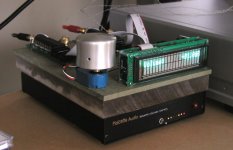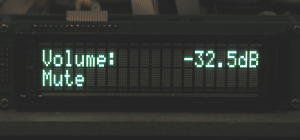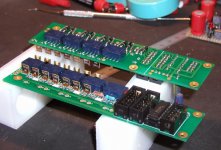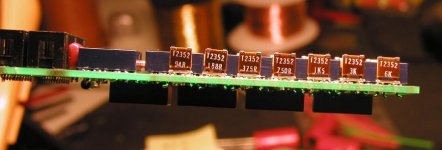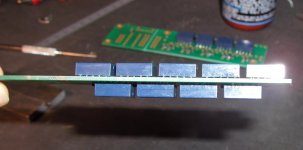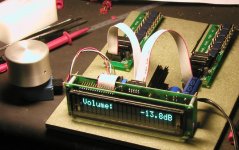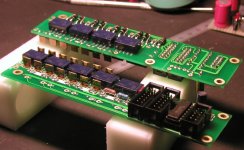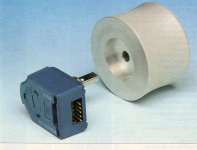Banned
Joined 2002
Peter Daniel said:$40/set (2 relay boards + display board)
Peter is that going to be with the display also ?
Does it come with a remote ? or just a optical encoder ?
jleaman said:
Peter is that going to be with the display also ?
Does it come with a remote ? or just a optical encoder ?
Those are for PCBs only.The circuit works with encoder and remote. I described the circuit here: http://www.diyaudio.com/forums/showthread.php?postid=1118699#post1118699
Since the pics disapeared I'm posting them again here. I would appreciate any suggestions for suitable display units.
Attachments
All credits with regards to control board, display and programing go to Veteran.
The relay board design was our combined effort, the attenuator concept was my idea, however, I was heavily inspired by Placette Audio. We have incorporated few changes though, like completely different layout, use of printed board for relays and resistors mounting and adding additonal 3 steps to lower the control range by another 12db or so.
The steps are also more uniform and the actual value of attenuation is being displayed. Mute function is also included.
The relay board design was our combined effort, the attenuator concept was my idea, however, I was heavily inspired by Placette Audio. We have incorporated few changes though, like completely different layout, use of printed board for relays and resistors mounting and adding additonal 3 steps to lower the control range by another 12db or so.
The steps are also more uniform and the actual value of attenuation is being displayed. Mute function is also included.
Attachments
Re: relay attenuators
Paypal is fine, add $6 for shipping. My paypal address can be found here: http://www.audiosector.com/contact.asp
houstonian said:I'll take 6 relay boards and a controller board. How do you prefer to be paid?
Paypal is fine, add $6 for shipping. My paypal address can be found here: http://www.audiosector.com/contact.asp
Banned
Joined 2002
Peter Daniel said:
Those are for PCBs only.The circuit works with encoder and remote. I described the circuit here: http://www.diyaudio.com/forums/showthread.php?postid=1118699#post1118699
Since the pics disapeared I'm posting them again here. I would appreciate any suggestions for suitable display units.
What about this one peter..
http://www.optrex.com/products/list.asp?SearchTerm=C-51505
I have one if you want i can send it to you to test out.
Same ones that we used in teh Cdr pro2's.
P.s digikey sells them too.
Part # is C-51505 Optrex.
Jase
For this version I decided to use nude Vishays, you need 28 resistors to complete the task. The PCB also allows the use of Caddocks, which have slightly wider footprint. I gues that type of attenuator will also work well with regular type of resistors.
The resistors are mounted in two rows (series and shunt separately), the relays bypass them, depending on attenuation. I wanted to achieve the shortest signal path and it seems like it was the only elegant way to do it. This requires SMD relays though.
The resistors are mounted in two rows (series and shunt separately), the relays bypass them, depending on attenuation. I wanted to achieve the shortest signal path and it seems like it was the only elegant way to do it. This requires SMD relays though.
Attachments
Banned
Joined 2002
jleaman said:Part # is C-51505 Optrex.
I had them in a CD-Pro and didn't like them at all because of poor visibility. I'm looking for vfd like in this picture:
Attachments
Stereomojo amp shootout
As you have alluded to in a previous post, amp shootouts such as the one just held, although done in a reasonably controlled way only tells you about how that amp performed with those particular speakers, preamp, source, room and to those respective listeners on that particular day. Pick another day, a different set of musical genres and you could have a different set of results. The conclusions on the whole were actually quite close, so none of the amps sounded 'bad.' There is not much to be taken from shootouts in general except for some good publicity for those respective manufacturers. I would implore you to take it with a huge grain of salt. At the end of the day, it all depends on how it sounds again, in your particular system . As for tweaking, Peter's take on the gainclone, imho is already tweaked (Peter has really, redefined tweaking for me. I just leave the unit alone since it sounds so refined!). There is really not much else to do, except for fooling around with snubbers and perhaps the capacitors specifically on the amp board itself. BG STD 1000uf vs. BG NX 100 uf vs. etc...you could like one set with classical but hate it with rock. Too many variables, too many choices. Tweaking for the sake of tweaking can be educational but can be frustrating as well. If it sounds good, leave it alone, especially since you might be tweaking while the amp is not even broken in yet!
. As for tweaking, Peter's take on the gainclone, imho is already tweaked (Peter has really, redefined tweaking for me. I just leave the unit alone since it sounds so refined!). There is really not much else to do, except for fooling around with snubbers and perhaps the capacitors specifically on the amp board itself. BG STD 1000uf vs. BG NX 100 uf vs. etc...you could like one set with classical but hate it with rock. Too many variables, too many choices. Tweaking for the sake of tweaking can be educational but can be frustrating as well. If it sounds good, leave it alone, especially since you might be tweaking while the amp is not even broken in yet!
To put it another way, I wouldn't take the comments mentioned by a few select souls in an amp shootout to indicate by any stretch of the imagination that the Audiosector amp has 'boomy sounding bass.' If I hooked up a 3 watt SET to an Apogee Stage or Thiel (both usually less than 86 dB/1w/1m and crazy impedance loads) I might have similar results.
I think its just cool that 14 amps got some PR and now we know they exist. That's it.
My $.02,
Anand.
My objective is not to hightlight the negatives of your product but to ask you why this might be. I find one possible explanation would be equipment partnership. The comment which is of particular interests is bass boomy and sound forward, my experience being that these qualities can be tweaked to be less prominent in light of equipment compatibility. You may like to advise us what needs to be done if we experienced the same situation.
Peter,
Your response did not answer my question on any tweaking(s) required, eg power supply, etc...
Does that mean I don't need to with Gainclone?
Every system is different, some tweaking is necessary in variety parts of the equipment maybe it be CD player, DAC or speakers and also applicable to amplifier.
If you don't believe tweaking so then we may have agree to disagree.
As you have alluded to in a previous post, amp shootouts such as the one just held, although done in a reasonably controlled way only tells you about how that amp performed with those particular speakers, preamp, source, room and to those respective listeners on that particular day. Pick another day, a different set of musical genres and you could have a different set of results. The conclusions on the whole were actually quite close, so none of the amps sounded 'bad.' There is not much to be taken from shootouts in general except for some good publicity for those respective manufacturers. I would implore you to take it with a huge grain of salt. At the end of the day, it all depends on how it sounds again, in your particular system
 . As for tweaking, Peter's take on the gainclone, imho is already tweaked (Peter has really, redefined tweaking for me. I just leave the unit alone since it sounds so refined!). There is really not much else to do, except for fooling around with snubbers and perhaps the capacitors specifically on the amp board itself. BG STD 1000uf vs. BG NX 100 uf vs. etc...you could like one set with classical but hate it with rock. Too many variables, too many choices. Tweaking for the sake of tweaking can be educational but can be frustrating as well. If it sounds good, leave it alone, especially since you might be tweaking while the amp is not even broken in yet!
. As for tweaking, Peter's take on the gainclone, imho is already tweaked (Peter has really, redefined tweaking for me. I just leave the unit alone since it sounds so refined!). There is really not much else to do, except for fooling around with snubbers and perhaps the capacitors specifically on the amp board itself. BG STD 1000uf vs. BG NX 100 uf vs. etc...you could like one set with classical but hate it with rock. Too many variables, too many choices. Tweaking for the sake of tweaking can be educational but can be frustrating as well. If it sounds good, leave it alone, especially since you might be tweaking while the amp is not even broken in yet!To put it another way, I wouldn't take the comments mentioned by a few select souls in an amp shootout to indicate by any stretch of the imagination that the Audiosector amp has 'boomy sounding bass.' If I hooked up a 3 watt SET to an Apogee Stage or Thiel (both usually less than 86 dB/1w/1m and crazy impedance loads) I might have similar results.
I think its just cool that 14 amps got some PR and now we know they exist. That's it.
My $.02,
Anand.
Peter Daniel said:
I had them in a CD-Pro and didn't like them at all because of poor visibility. I'm looking for vfd like in this picture:
looks great when you source out the proper vfd ill take two relay boards and a control board.
cheers
DeanP said:Peter,
Quick question, how wide is the lm4780 amp board?
The amp board is 2.9 x 1.4 ; rectifier board is 2.9 x 1.2"
rnzr said:
is 3A fuse enough for my gainclone if i have dual-mono deisign (LM3875) and two toroidals (each 2x21V 225VA)?
and which one should i buy - slow or fast fuse?
i live in europe (220V).
You need slow blow fuse and 3 A is enough for each toroid. If you use one fuse for two toroids, it may work too, and if it blows, just use higher value.
- Status
- This old topic is closed. If you want to reopen this topic, contact a moderator using the "Report Post" button.
- Home
- More Vendors...
- Audio Sector
- AudioSector-chip amp kits, dacs, chassis
